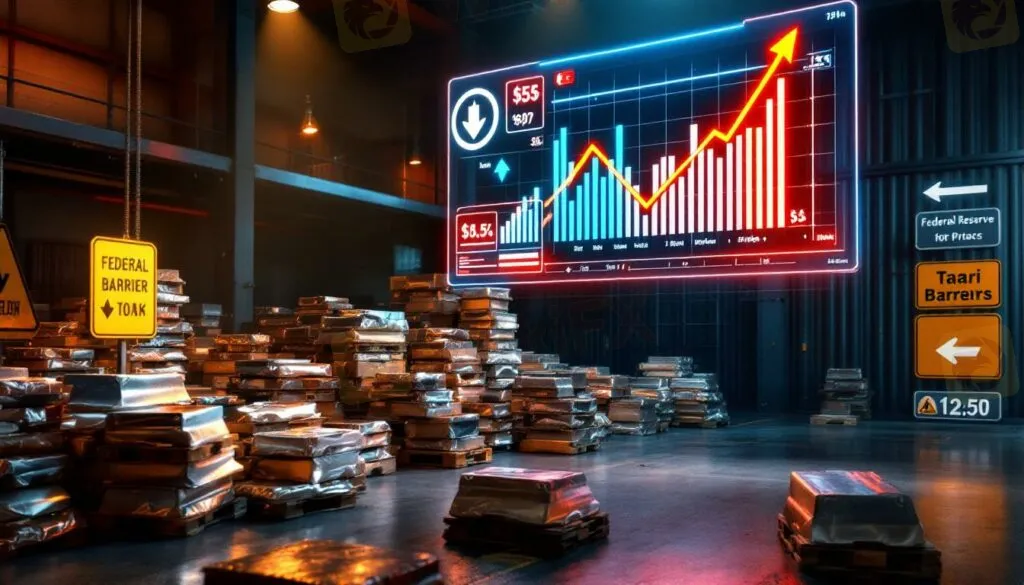简体中文
繁體中文
English
Pусский
日本語
ภาษาไทย
Tiếng Việt
Bahasa Indonesia
Español
हिन्दी
Filippiiniläinen
Français
Deutsch
Português
Türkçe
한국어
العربية
How Are Trade Policies Affecting the Aluminum Market?
Abstract:Trade policy developments have emerged as a critical driver of aluminum market dynamics in 2025.
Trade policy developments have emerged as a critical driver of aluminum market dynamics in 2025.
EU-US Trade Tensions
The EU's first phase of countermeasures against US tariffs automatically takes effect July 14, targeting sectors including steel, automobiles, and copper. While aluminum is not directly named in the initial measures, the metal's integration across these targeted value chains creates significant indirect exposure.
As Bernd Lange noted, these measures represent only the “first phase” of potential escalation, suggesting aluminum could face similar direct trade barriers in subsequent rounds. The resulting US–China trade war impact will likely intensify across industrial metals as companies adjust procurement strategies.
Impact on Global Aluminum Flows
Trade tensions are already redirecting global aluminum flows as exporters seek alternative markets for their production. This redirection creates potential for widening regional price disparities as traditional trade patterns adjust to new barriers.
Compliance costs for cross-border aluminum trade have increased substantially, with documentation requirements, origin certification, and tariff management adding approximately 2-3% to transaction costs according to market participants. These increased friction costs contribute to price premiums in affected markets.
The competitive landscape for aluminum-intensive industries is shifting in response, with manufacturers reassessing supply chain strategies and potentially relocating production to minimize tariff exposure.

Policy Monitoring Priorities
Market participants should closely monitor several policy developments:
- Implementation details of EU countermeasures
- Potential US response to EU actions
- Broader trade policy developments affecting industrial metals
- Regional regulatory changes impacting aluminum production costs
The evolution of these policies will significantly influence both regional and global aluminum price dynamics through 2025 and beyond.
How do inventory levels affect aluminum prices?
Low inventory levels typically support aluminum prices by creating supply tightness, while high inventories generally pressure prices downward. Currently, the ongoing destocking trend in social inventories (down to 466,000 metric tons) is providing price support despite seasonal demand weakness.
When inventory levels approach the 400,000 metric ton threshold in Chinese markets, historical patterns suggest significant upward price pressure becomes likely, particularly if restocking demand emerges simultaneously.
What impact do Federal Reserve policies have on aluminum markets?
Fed policies affect interest rates and the US dollar value, which directly influence aluminum prices and macro factors. Higher interest rates typically strengthen the dollar, making dollar-denominated aluminum more expensive for foreign buyers, potentially reducing demand and pressuring prices.
Additionally, interest rate changes affect financing costs for aluminum stockholders and producers, influencing inventory carrying decisions and production economics. The current Fed policy uncertainty has contributed to price volatility as market participants adjust positions based on evolving rate expectations.
How do seasonal factors affect aluminum demand?
Aluminum demand typically experiences a summer lull in July-August, with reduced construction and manufacturing activity. This seasonal pattern creates cyclical price pressure that must be balanced against supply-side factors when forecasting price movements.
The seasonal weakness is particularly pronounced in construction-related applications but less significant in packaging and transportation sectors. Market participants generally anticipate this pattern and adjust inventory strategies accordingly, moderating price impacts.
What role do secondary aluminum markets play in price formation?
Secondary aluminum provides an alternative supply source that can help moderate primary aluminum prices. However, when scrap supplies tighten (as currently observed), this alternative becomes less available, potentially supporting primary aluminum prices.
The current production cuts across secondary smelters due to raw material shortages and cost pressures illustrate how interconnected these markets have become. The price relationship between primary and secondary aluminum serves as an important indicator of overall market health and balance.
How might trade tensions impact aluminum prices in the coming months?
Escalating trade barriers between major economies could disrupt established supply chains, potentially creating regional price disparities and increased volatility. The implementation of new tariffs or quotas could raise costs throughout the aluminum value chain.
While primary aluminum has not yet been directly targeted by EU countermeasures, its extensive use in affected sectors creates significant indirect exposure. Market participants should prepare for potential direct targeting in subsequent rounds of trade measures, which could create more pronounced regional price disconnections.
Key Aluminum Market Statistics Table
| Metric | Current Value | Change | Impact |
| Primary Aluminum Inventory | 466,000 mt | -8,000 mt week-over-week | Bullish |
| Three-Region Inventory | 325,500 mt | -6,500 mt day-over-day | Bullish |
| SMM A00 Spot Price | 20,660 yuan/mt | +60 yuan/mt day-over-day | Bullish |
| SHFE 2508 Contract Close | 20,685 yuan/mt | – | Neutral |
| LME Aluminum Close | $2,602/mt | – | Neutral |
| Henan-Shanghai Price Spread | -110 yuan/mt | Narrowed by 10 yuan/mt | Neutral |
| UBC Scrap Price Range | 15,300-15,800 yuan/mt | +50 yuan/mt month-over-month | Bullish for costs |
| ADC12 Alloy Price | 20,000 yuan/mt | Unchanged | Neutral |
Disclaimer:
The views in this article only represent the author's personal views, and do not constitute investment advice on this platform. This platform does not guarantee the accuracy, completeness and timeliness of the information in the article, and will not be liable for any loss caused by the use of or reliance on the information in the article.
WikiFX Broker
Latest News
Alchemy Markets Review 2025: Key Facts and Insights
FXPRIMUS: 5 Things They Don’t Want You to Know
Temasek's portfolio scales new peak even as divestments hit over 2-decade high
5 Serious Warnings About Mirrox! You Can’t Afford to Ignore
Exposing Trade Capital Limited - Siphoning Millions, Restricting Withdrawals, Charging Extra Fees
How Do I Place a Stop-loss Order?
Largest Market Makers
Bitcoin rises to fresh record above $112,000, helped by Nvidia-led tech rally
Stock futures are little changed after S&P 500 posts first winning session in three: Live updates
Nvidia briefly touched $4 trillion market cap for first time
Currency Calculator


